Enhanced Land-Cover Classification through a Multi-Stage Classification Strategy Integrating LiDAR and SIF Data
Abstract
1. Introduction
2. Materials
2.1. Study Area
2.2. Experimental Data
3. Methods
3.1. Feature Extraction
3.1.1. LiDAR Feature Extraction
3.1.2. SIF Acquisition and Feature Extraction
3.2. Land-Cover Classification
4. Results
4.1. Feature Extraction
4.2. Classification of Solely LiDAR and the Combined LiDAR-SIF Data with One-Step Approach
4.3. Classification of the Combined LiDAR and SIF Data with Multi-Stage Classification Strategy
5. Discussion
5.1. Analysis of the SIF-Enhanced Classification Effectiveness Using LiDAR Data
5.2. Exploration of the Classification Results through Fusion of LiDAR and SIF Data Utilizing Multi-Stage Classification Strategy
5.3. Limitations and Expectations for the Current Research
6. Conclusions
Author Contributions
Funding
Data Availability Statement
Acknowledgments
Conflicts of Interest
References
- Pan, S.; Guan, H.; Chen, Y.; Yu, Y.; Nunes Gonçalves, W.; Marcato Junior, J.; Li, J. Land-Cover Classification of Multispectral LiDAR Data Using CNN with Optimized Hyper-Parameters. ISPRS J. Photogramm. Remote Sens. 2020, 166, 241–254. [Google Scholar] [CrossRef]
- Antonarakis, A.S.; Richards, K.S.; Brasington, J. Object-Based Land Cover Classification Using Airborne LiDAR. Remote Sens. Environ. 2008, 112, 2988–2998. [Google Scholar] [CrossRef]
- Object-Based Land Cover Classification Using High-Posting-Density LiDAR Data. GISci. Remote Sens. 2008, 45, 209–228. Available online: https://www.tandfonline.com/doi/abs/10.2747/1548-1603.45.2.209 (accessed on 18 March 2024). [CrossRef]
- Yan, W.Y.; Shaker, A.; El-Ashmawy, N. Urban Land Cover Classification Using Airborne LiDAR Data: A Review. Remote Sens. Environ. 2015, 158, 295–310. [Google Scholar] [CrossRef]
- Sebastian, G.; Vattem, T.; Lukic, L.; Bürgy, C.; Schumann, T. RangeWeatherNet for LiDAR-Only Weather and Road Condition Classification. In Proceedings of the 2021 IEEE Intelligent Vehicles Symposium (IV), Nagoya, Japan, 11–17 July 2021; pp. 777–784. [Google Scholar]
- Swatantran, A.; Tang, H.; Barrett, T.; DeCola, P.; Dubayah, R. Rapid, High-Resolution Forest Structure and Terrain Mapping over Large Areas Using Single Photon Lidar. Sci. Rep. 2016, 6, 28277. [Google Scholar] [CrossRef]
- Bijelic, M.; Gruber, T.; Mannan, F.; Kraus, F.; Ritter, W.; Dietmayer, K.; Heide, F. Seeing through Fog without Seeing Fog: Deep Multimodal Sensor Fusion in Unseen Adverse Weather. In Proceedings of the 2020 IEEE/CVF Conference on Computer Vision and Pattern Recognition (CVPR), Seattle, WA, USA, 13–19 June 2020; pp. 11682–11692. [Google Scholar]
- Wallace, A.M.; Halimi, A.; Buller, G.S. Full Waveform LiDAR for Adverse Weather Conditions. IEEE Trans. Veh. Technol. 2020, 69, 7064–7077. [Google Scholar] [CrossRef]
- Song, J.-H.; Han, S.-H.; Yu, K.Y.; Kim, Y.-I. Assessing the Possibility of Land-Cover Classification Using Lidar Intensity Data. Int. Arch. Photogramm. Remote Sens. Spat. Inf. Sci. 2002, 34, 259–262. [Google Scholar]
- Zhou, W. An Object-Based Approach for Urban Land Cover Classification: Integrating LiDAR Height and Intensity Data. IEEE Geosci. Remote Sens. Lett. 2013, 10, 928–931. [Google Scholar] [CrossRef]
- Rossini, M.; Nedbal, L.; Guanter, L.; Ač, A.; Alonso, L.; Burkart, A.; Cogliati, S.; Colombo, R.; Damm, A.; Drusch, M.; et al. Red and Far Red Sun-induced Chlorophyll Fluorescence as a Measure of Plant Photosynthesis. Geophys. Res. Lett. 2015, 42, 1632–1639. [Google Scholar] [CrossRef]
- Jonard, F.; De Canniere, S.; Brüggemann, N.; Gentine, P.; Gianotti, D.S.; Lobet, G.; Miralles, D.G.; Montzka, C.; Pagán, B.R.; Rascher, U. Value of Sun-Induced Chlorophyll Fluorescence for Quantifying Hydrological States and Fluxes: Current Status and Challenges. Agric. For. Meteorol. 2020, 291, 108088. [Google Scholar] [CrossRef]
- Aasen, H.; Van Wittenberghe, S.; Sabater Medina, N.; Damm, A.; Goulas, Y.; Wieneke, S.; Hueni, A.; Malenovskỳ, Z.; Alonso, L.; Pacheco-Labrador, J. Sun-Induced Chlorophyll Fluorescence II: Review of Passive Measurement Setups, Protocols, and Their Application at the Leaf to Canopy Level. Remote Sens. 2019, 11, 927. [Google Scholar] [CrossRef]
- Sun, Y.; Frankenberg, C.; Wood, J.D.; Schimel, D.S.; Jung, M.; Guanter, L.; Drewry, D.T.; Verma, M.; Porcar-Castell, A.; Griffis, T.J.; et al. OCO-2 Advances Photosynthesis Observation from Space via Solar-Induced Chlorophyll Fluorescence. Science 2017, 358, eaam5747. [Google Scholar] [CrossRef]
- Daumard, F.; Goulas, Y.; Champagne, S.; Fournier, A.; Ounis, A.; Olioso, A.; Moya, I. Continuous Monitoring of Canopy Level Sun-Induced Chlorophyll Fluorescence during the Growth of a Sorghum Field. IEEE Trans. Geosci. Remote Sens. 2012, 50, 4292–4300. [Google Scholar] [CrossRef]
- Pinto, F.; Celesti, M.; Acebron, K.; Alberti, G.; Cogliati, S.; Colombo, R.; Juszczak, R.; Matsubara, S.; Miglietta, F.; Palombo, A.; et al. Dynamics of Sun-induced Chlorophyll Fluorescence and Reflectance to Detect Stress-induced Variations in Canopy Photosynthesis. Plant Cell Environ. 2020, 43, 1637–1654. [Google Scholar] [CrossRef] [PubMed]
- Liu, L.; Guan, L.; Liu, X. Directly Estimating Diurnal Changes in GPP for C3 and C4 Crops Using Far-Red Sun-Induced Chlorophyll Fluorescence. Agric. For. Meteorol. 2017, 232, 1–9. [Google Scholar] [CrossRef]
- Chen, S.; Huang, Y.; Wang, G. Detecting Drought-Induced GPP Spatiotemporal Variabilities with Sun-Induced Chlorophyll Fluorescence during the 2009/2010 Droughts in China. Ecol. Indic. 2021, 121, 107092. [Google Scholar] [CrossRef]
- Daumard, F.; Champagne, S.; Fournier, A.; Goulas, Y.; Ounis, A.; Hanocq, J.-F.; Moya, I. A Field Platform for Continuous Measurement of Canopy Fluorescence. IEEE Trans. Geosci. Remote Sens. 2010, 48, 3358–3368. [Google Scholar] [CrossRef]
- Yang, P.; van der Tol, C.; Verhoef, W.; Damm, A.; Schickling, A.; Kraska, T.; Muller, O.; Rascher, U. Using Reflectance to Explain Vegetation Biochemical and Structural Effects on Sun-Induced Chlorophyll Fluorescence. Remote Sens. Environ. 2019, 231, 110996. [Google Scholar] [CrossRef]
- Watanachaturaporn, P.; Arora, M.K.; Varshney, P.K. Multisource Classification Using Support Vector Machines. Photogramm. Eng. Remote Sens. 2008, 74, 239–246. [Google Scholar] [CrossRef]
- Pedergnana, M.; Marpu, P.R.; Dalla Mura, M.; Benediktsson, J.A.; Bruzzone, L. Classification of Remote Sensing Optical and LiDAR Data Using Extended Attribute Profiles. IEEE J. Sel. Top. Signal Process. 2012, 6, 856–865. [Google Scholar] [CrossRef]
- Xu, L.; Shi, S.; Gong, W.; Chen, B.; Sun, J.; Xu, Q.; Bi, S. Mapping 3D Plant Chlorophyll Distribution from Hyperspectral LiDAR by a Leaf-Canopyradiative Transfer Model. Int. J. Appl. Earth Obs. Geoinf. 2024, 127, 103649. [Google Scholar] [CrossRef]
- Xu, L.; Shi, S.; Gong, W.; Shi, Z.; Qu, F.; Tang, X.; Chen, B.; Sun, J. Improving Leaf Chlorophyll Content Estimation through Constrained PROSAIL Model from Airborne Hyperspectral and LiDAR Data. Int. J. Appl. Earth Obs. Geoinf. 2022, 115, 103128. [Google Scholar] [CrossRef]
- Teo, T.-A.; Huang, C.-H. Object-Based Land Cover Classification Using Airborne Lidar and Different Spectral Images. TAO Terr. Atmos. Ocean. Sci. 2016, 27, 491. [Google Scholar] [CrossRef]
- Lu, D.; Hetrick, S.; Moran, E. Land Cover Classification in a Complex Urban-Rural Landscape with QuickBird Imagery. Photogramm. Eng. Remote Sens. 2010, 76, 1159–1168. [Google Scholar] [CrossRef] [PubMed]
- Buján, S.; González-Ferreiro, E.; Reyes-Bueno, F.; Barreiro-Fernández, L.; Crecente, R.; Miranda, D. Land Use Classification from Lidar Data and Ortho-Images in a Rural Area. Photogramm. Rec. 2012, 27, 401–422. [Google Scholar] [CrossRef]
- Brown, D.G.; Johnson, K.M.; Loveland, T.R.; Theobald, D.M. Rural land-use trends in the conterminous united states, 1950–2000. Ecol. Appl. 2005, 15, 1851–1863. [Google Scholar] [CrossRef]
- Rogan, J.; Chen, D. Remote Sensing Technology for Mapping and Monitoring Land-Cover and Land-Use Change. Prog. Plan. 2004, 61, 301–325. [Google Scholar] [CrossRef]
- Tilahun, A.; Teferie, B. Accuracy Assessment of Land Use Land Cover Classification Using Google Earth. Am. J. Environ. Prot. 2015, 4, 193–198. [Google Scholar] [CrossRef]
- Jansen, L.J.; Di Gregorio, A. Land-Use Data Collection Using the “Land Cover Classification System”: Results from a Case Study in Kenya. Land. Use Policy 2003, 20, 131–148. [Google Scholar] [CrossRef]
- Vargo, J.; Habeeb, D.; Stone, B., Jr. The Importance of Land Cover Change across Urban–Rural Typologies for Climate Modeling. J. Environ. Manag. 2013, 114, 243–252. [Google Scholar] [CrossRef]
- RIEGL—Produktdetail. Available online: http://www.riegl.com/nc/products/airborne-scanning/produktdetail/product/scanner/69/ (accessed on 19 March 2024).
- Miko Scientists Confirm Specim’s AisaIBIS Reliably Measures Plant Stress. Specim 2015. Available online: https://www.specim.com/scientists-confirm-specims-aisaibis-reliably-measures-plant-stress/ (accessed on 19 March 2024).
- Jakubowski, M.K.; Li, W.; Guo, Q.; Kelly, M. Delineating Individual Trees from LiDAR Data: A Comparison of Vector-and Raster-Based Segmentation Approaches. Remote Sens. 2013, 5, 4163–4186. [Google Scholar] [CrossRef]
- Budei, B.C.; St-Onge, B. Variability of Multispectral Lidar 3D and Intensity Features with Individual Tree Height and Its Influence on Needleleaf Tree Species Identification. Can. J. Remote Sens. 2018, 44, 263–286. [Google Scholar] [CrossRef]
- Liu, X.; Zhang, Z.; Peterson, J.; Chandra, S. The Effect of LiDAR Data Density on DEM Accuracy. In Proceedings of the 17th International Congress on Modelling and Simulation (MODSIM07), Canberra, Australia, 10–13 December 2007; Modelling and Simulation Society of Australia and New Zealand: Canberra, Australia, 2007. [Google Scholar]
- Chehata, N.; Guo, L.; Mallet, C. Airborne Lidar Feature Selection for Urban Classification Using Random Forests. In Proceedings of the Laserscanning, Paris, France, 1–2 September 2009. [Google Scholar]
- Ramadhani, A.N.R. An Analysis of the Three-Dimensional Modelling Using LiDAR Data and Unmanned Aerial Vehicle (UAV) (Case Study: Institut Teknologi Sepuluh Nopember, Sukolilo Campus). In IOP Conference Series: Earth and Environmental Science; IOP Publishing: Bristol, UK, 2023; Volume 1127, p. 012010. [Google Scholar]
- Brodu, N.; Lague, D. 3D Terrestrial Lidar Data Classification of Complex Natural Scenes Using a Multi-Scale Dimensionality Criterion: Applications in Geomorphology. ISPRS J. Photogramm. Remote Sens. 2012, 68, 121–134. [Google Scholar] [CrossRef]
- Automatic Detection and Mapping of Highway Guardrails from Mobile Lidar Point Clouds|IEEE Conference Publication|IEEE Xplore. Available online: https://ieeexplore.ieee.org/abstract/document/9553055 (accessed on 19 March 2024).
- Daumard, F.; Goulas, Y.; Ounis, A.; Pedrós, R.; Moya, I. Measurement and Correction of Atmospheric Effects at Different Altitudes for Remote Sensing of Sun-Induced Fluorescence in Oxygen Absorption Bands. IEEE Trans. Geosci. Remote Sens. 2015, 53, 5180–5196. [Google Scholar] [CrossRef]
- Damm, A.; Guanter, L.; Laurent, V.C.; Schaepman, M.E.; Schickling, A.; Rascher, U. FLD-Based Retrieval of Sun-Induced Chlorophyll Fluorescence from Medium Spectral Resolution Airborne Spectroscopy Data. Remote Sens. Environ. 2014, 147, 256–266. [Google Scholar] [CrossRef]
- Plascyk, J.A.; Gabriel, F.C. The Fraunhofer Line Discriminator MKII-an Airborne Instrument for Precise and Standardized Ecological Luminescence Measurement. IEEE Trans. Instrum. Meas. 1975, 24, 306–313. [Google Scholar] [CrossRef]
- Plascyk, J.A. The MK II Fraunhofer Line Discriminator (FLD-II) for Airborne and Orbital Remote Sensing of Solar-Stimulated Luminescence. Opt. Eng. 1975, 14, 339. [Google Scholar] [CrossRef]
- Zhang, Y.; Guanter, L.; Berry, J.A.; Joiner, J.; Van Der Tol, C.; Huete, A.; Gitelson, A.; Voigt, M.; Köhler, P. Estimation of Vegetation Photosynthetic Capacity from Space-based Measurements of Chlorophyll Fluorescence for Terrestrial Biosphere Models. Glob. Chang. Biol. 2014, 20, 3727–3742. [Google Scholar] [CrossRef]
- Yang, H.; Yang, X.; Zhang, Y.; Heskel, M.A.; Lu, X.; Munger, J.W.; Sun, S.; Tang, J. Chlorophyll Fluorescence Tracks Seasonal Variations of Photosynthesis from Leaf to Canopy in a Temperate Forest. Glob. Chang. Biol. 2017, 23, 2874–2886. [Google Scholar] [CrossRef]
- Guanter, L.; Zhang, Y.; Jung, M.; Joiner, J.; Voigt, M.; Berry, J.A.; Frankenberg, C.; Huete, A.R.; Zarco-Tejada, P.; Lee, J.-E.; et al. Global and Time-Resolved Monitoring of Crop Photosynthesis with Chlorophyll Fluorescence. Proc. Natl. Acad. Sci. USA 2014, 111, E1327–E1333. [Google Scholar] [CrossRef]
- Song, Y.-Y.; Ying, L.U. Decision Tree Methods: Applications for Classification and Prediction. Shanghai Arch. Psychiatry 2015, 27, 130. [Google Scholar] [PubMed]
- Charbuty, B.; Abdulazeez, A. Classification Based on Decision Tree Algorithm for Machine Learning. J. Appl. Sci. Technol. Trends 2021, 2, 20–28. [Google Scholar] [CrossRef]
- Myles, A.J.; Feudale, R.N.; Liu, Y.; Woody, N.A.; Brown, S.D. An Introduction to Decision Tree Modeling. J. Chemom. 2004, 18, 275–285. [Google Scholar] [CrossRef]
- Breiman, L. Random Forests. Mach. Learn. 2001, 45, 5–32. [Google Scholar] [CrossRef]
- Biau, G. Analysis of a Random Forests Model. J. Mach. Learn. Res. 2012, 13, 1063–1095. [Google Scholar]
- Bui, Q.-T.; Chou, T.-Y.; Hoang, T.-V.; Fang, Y.-M.; Mu, C.-Y.; Huang, P.-H.; Pham, V.-D.; Nguyen, Q.-H.; Anh, D.T.N.; Pham, V.-M. Gradient Boosting Machine and Object-Based CNN for Land Cover Classification. Remote Sens. 2021, 13, 2709. [Google Scholar] [CrossRef]
- McCarty, D.A.; Kim, H.W.; Lee, H.K. Evaluation of Light Gradient Boosted Machine Learning Technique in Large Scale Land Use and Land Cover Classification. Environments 2020, 7, 84. [Google Scholar] [CrossRef]
- Ke, G.; Meng, Q.; Finley, T.; Wang, T.; Chen, W.; Ma, W.; Ye, Q.; Liu, T.-Y. Lightgbm: A Highly Efficient Gradient Boosting Decision Tree. Adv. Neural Inf. Process. Syst. 2017, 30, 1–9. [Google Scholar]
- Torlay, L.; Perrone-Bertolotti, M.; Thomas, E.; Baciu, M. Machine Learning–XGBoost Analysis of Language Networks to Classify Patients with Epilepsy. Brain Inf. 2017, 4, 159–169. [Google Scholar] [CrossRef]
- Ramraj, S.; Uzir, N.; Sunil, R.; Banerjee, S. Experimenting XGBoost Algorithm for Prediction and Classification of Different Datasets. Int. J. Control Theory Appl. 2016, 9, 651–662. [Google Scholar]
- Chen, T.; Guestrin, C. XGBoost: A Scalable Tree Boosting System. In Proceedings of the 22nd ACM SIGKDD International Conference on Knowledge Discovery and Data Mining, San Francisco, CA, USA, 13 August 2016; ACM: New York, NY, USA, 2016; pp. 785–794. [Google Scholar]

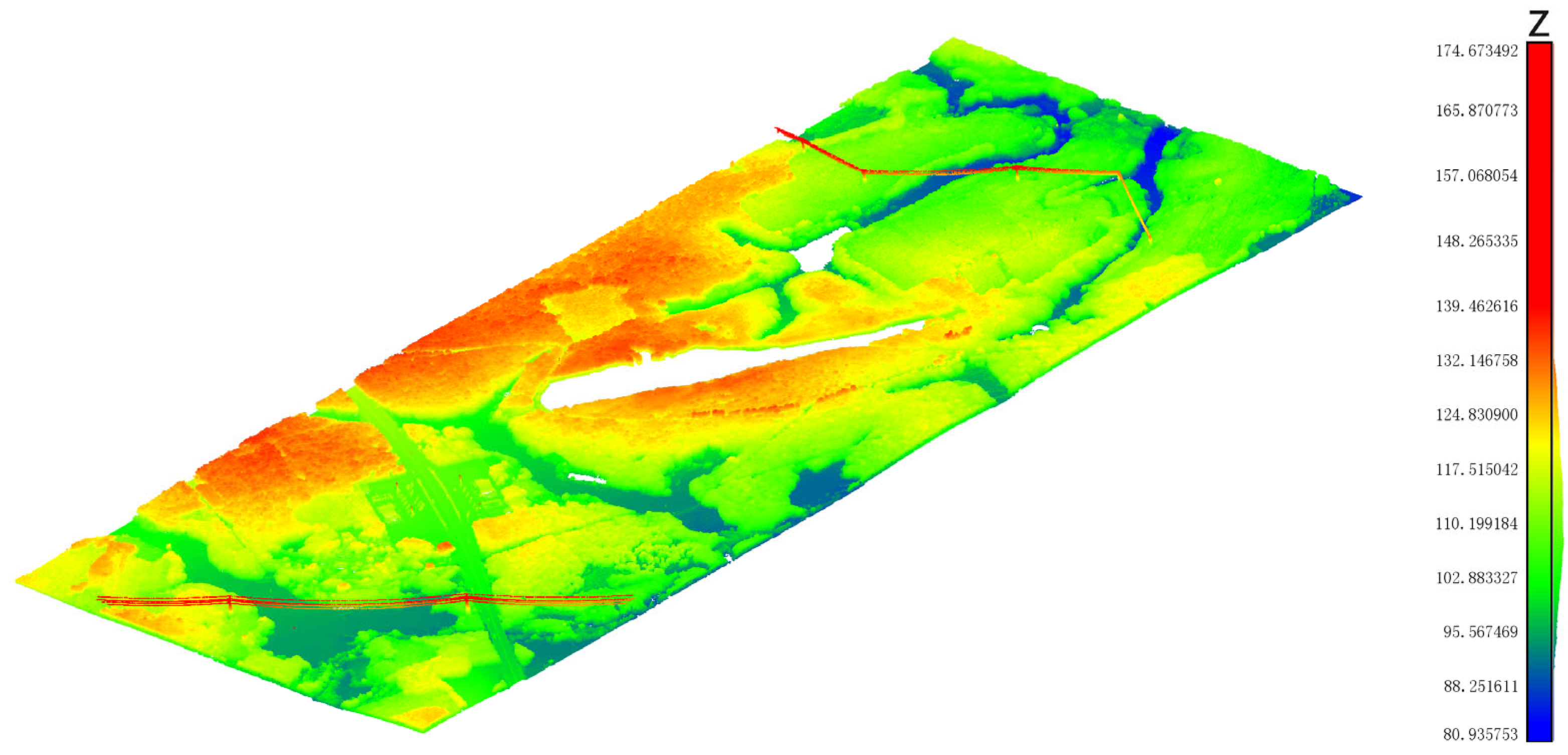

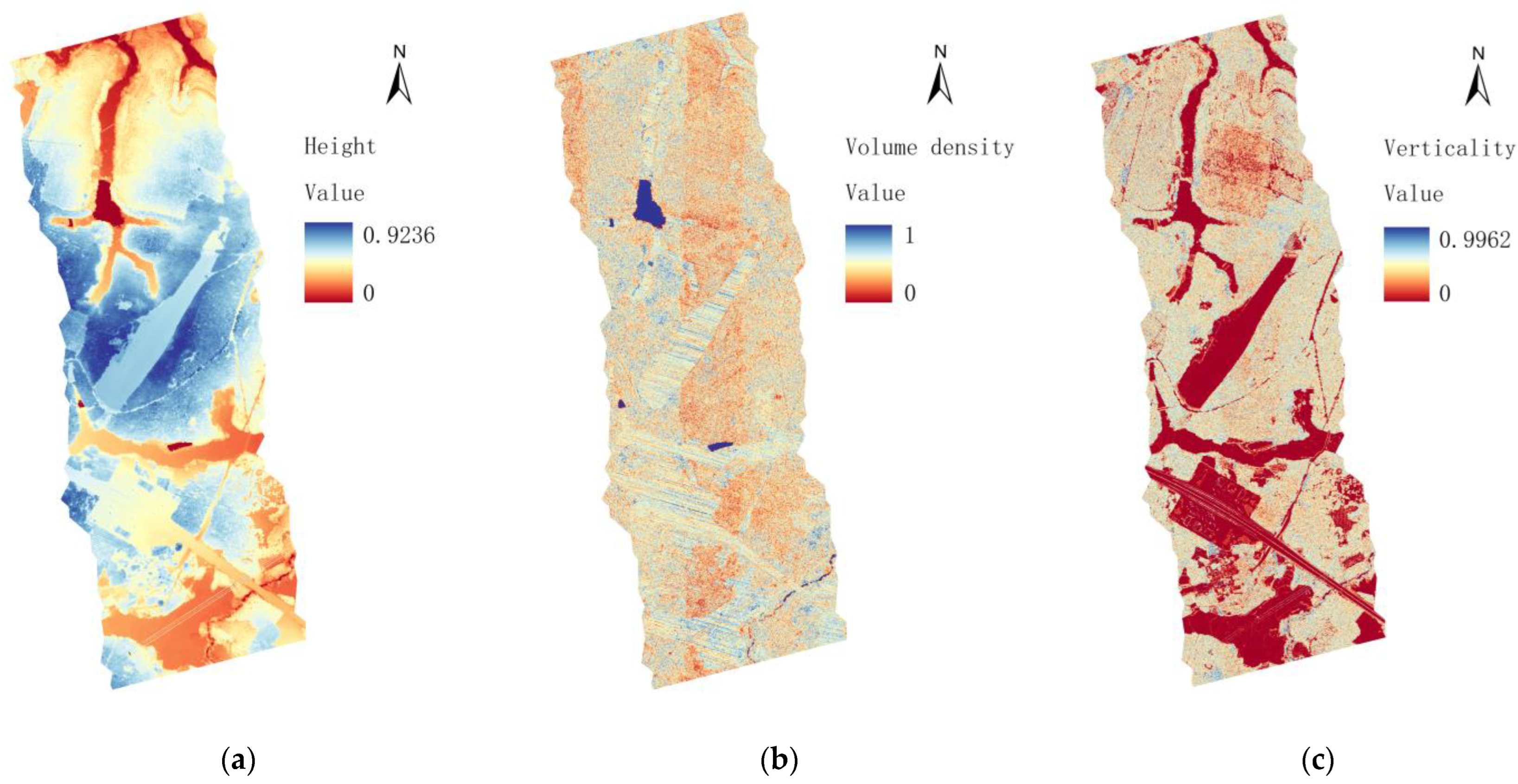
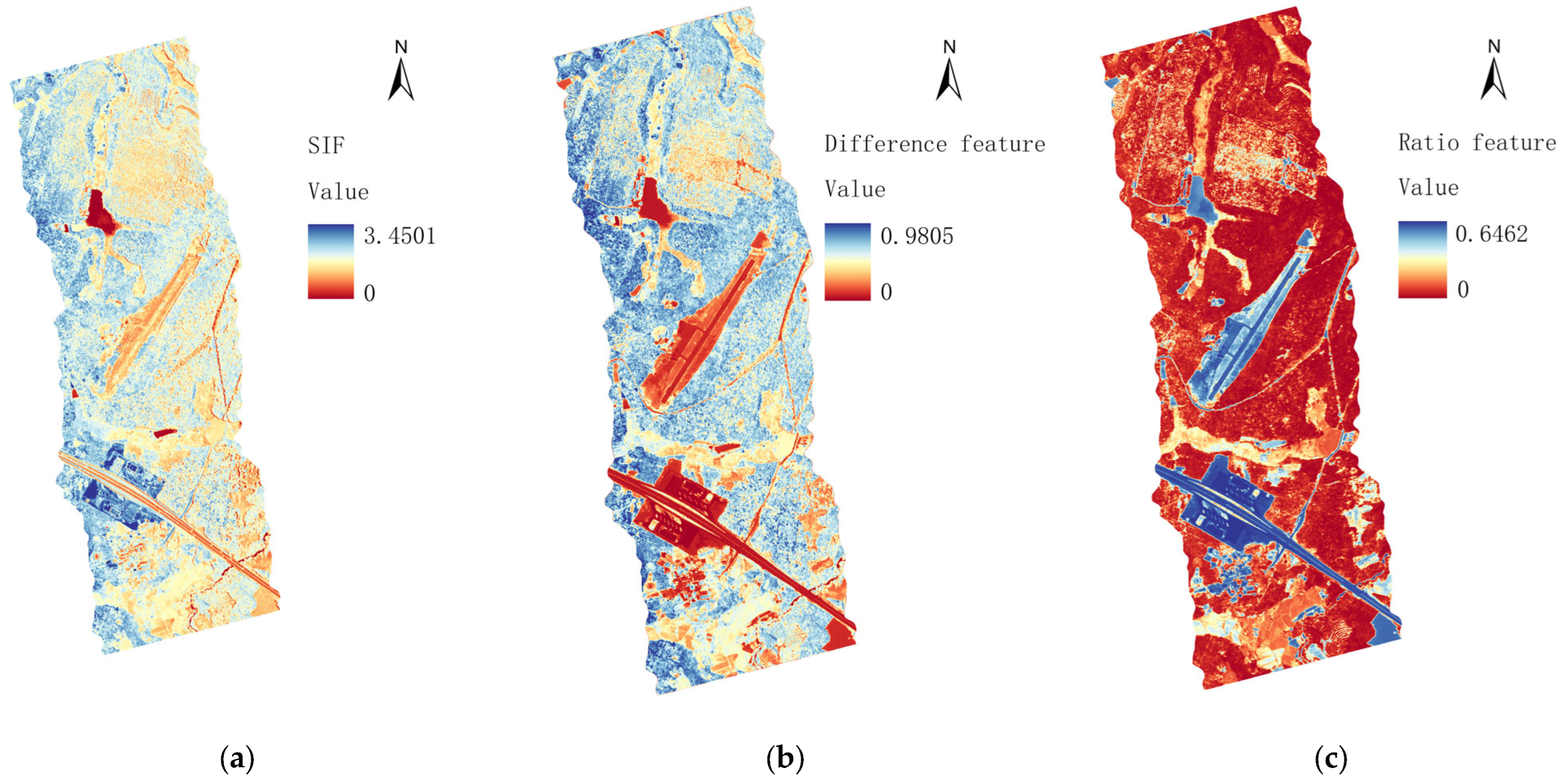
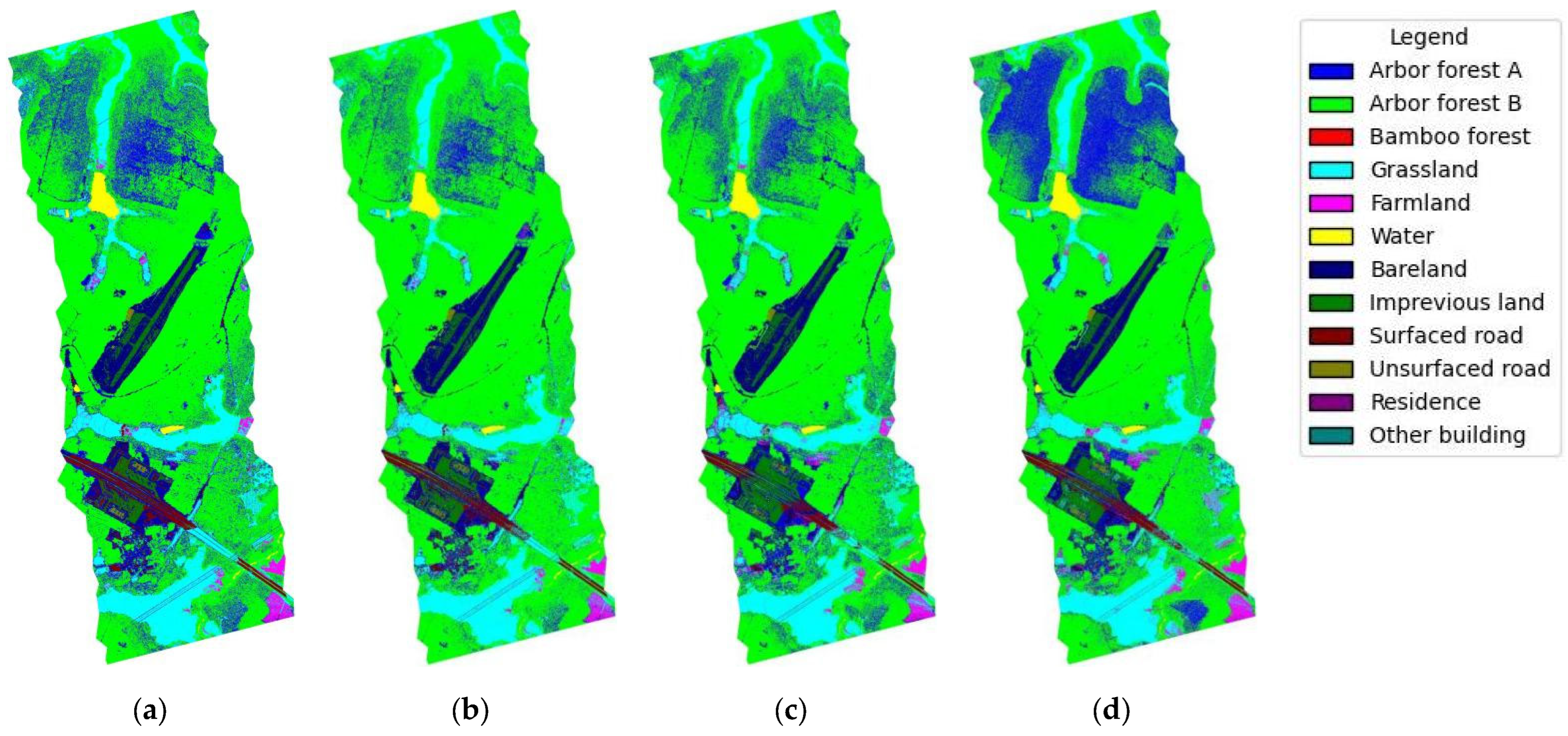
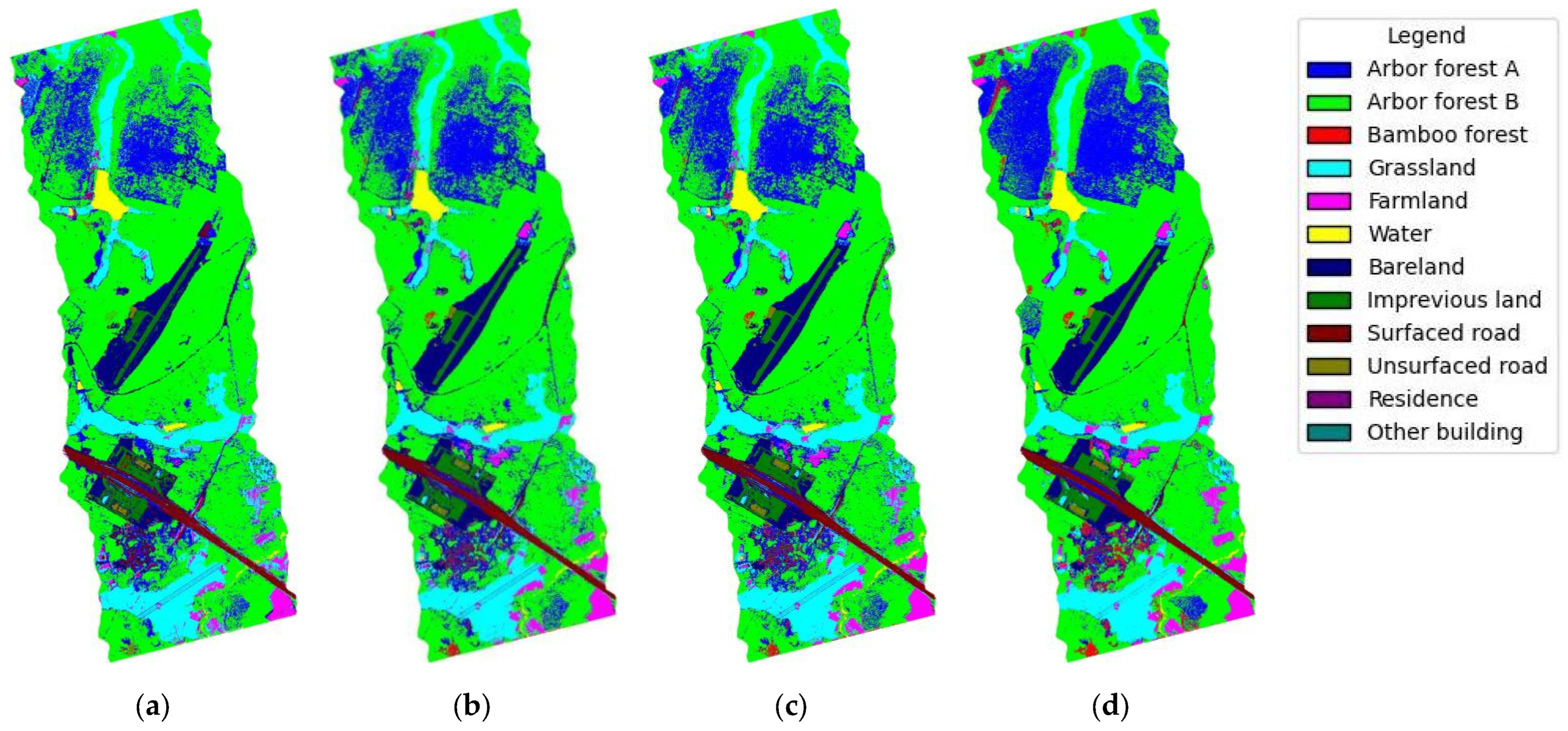
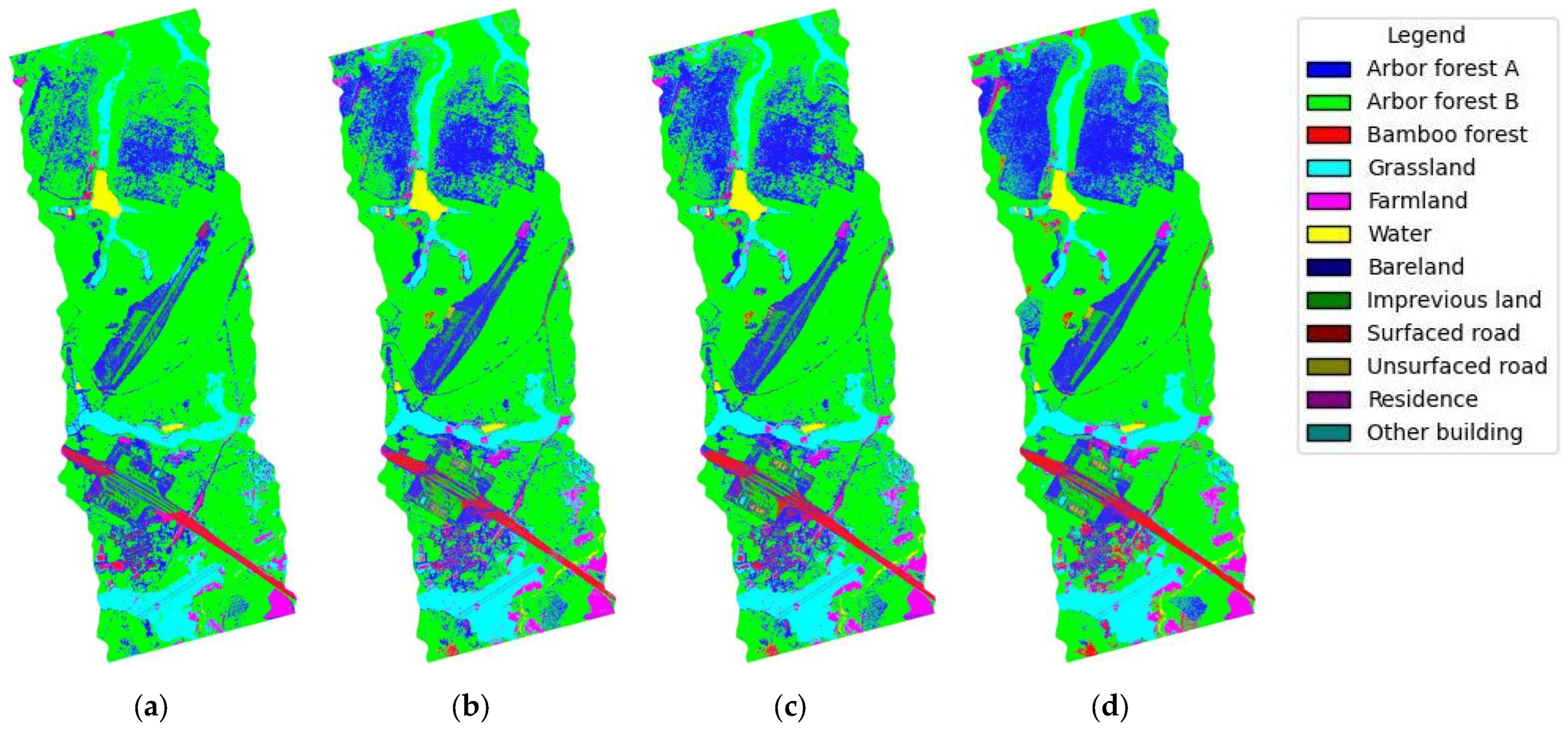


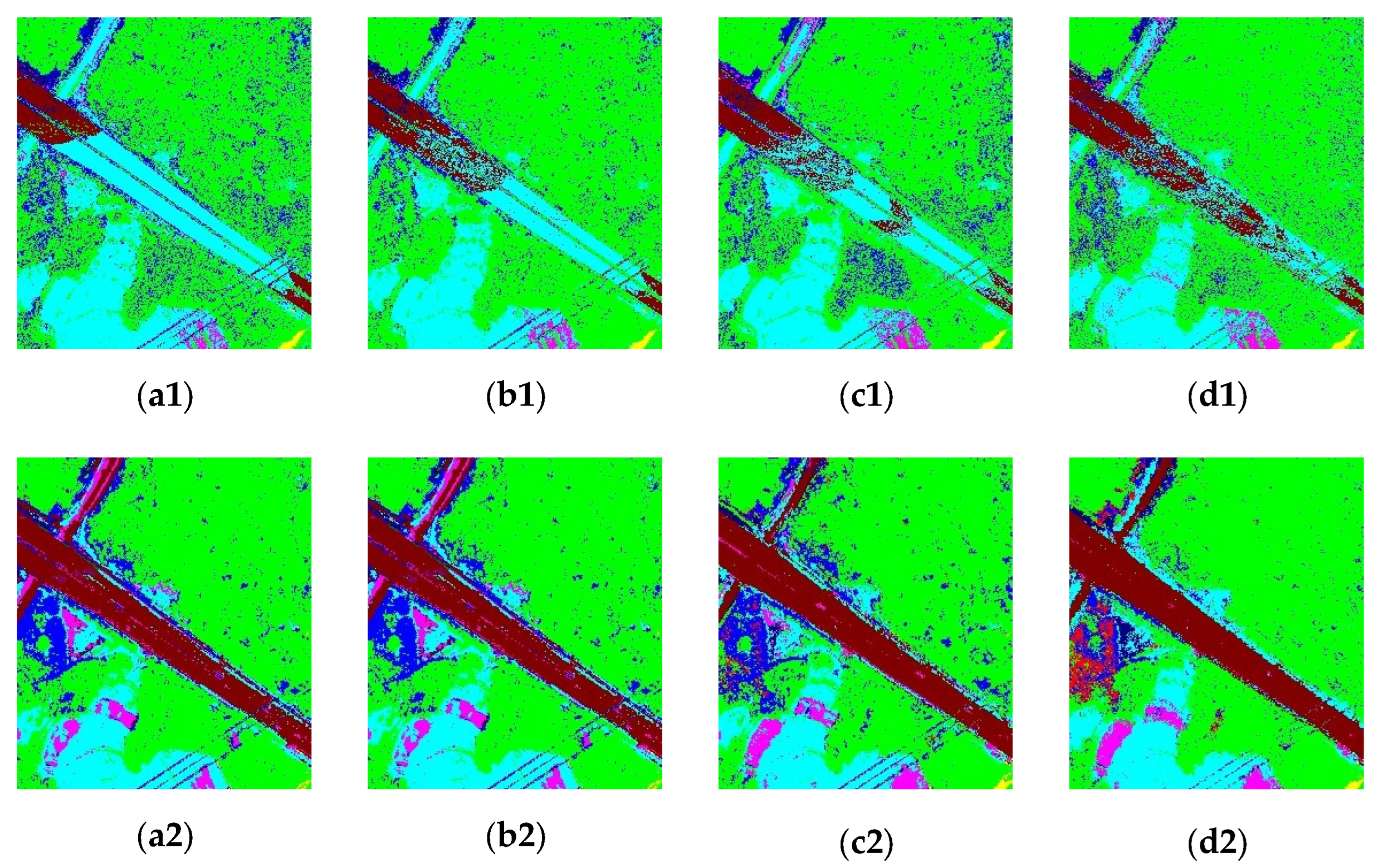
| Vegetation | Non-Vegetation | Overall Accuracy | |
|---|---|---|---|
| Decision tree classifier | 96.45% | 84.77% | 96.41% |
| LightGBM classifier | 97.95% | 79.04% | 96.81% |
| XGBoost classifier | 97.97% | 78.70% | 96.79% |
| Random forest classifier | 98.92% | 83.69% | 97.71% |
| Data | LiDAR | LiDAR and Multi-Spectral Image | LiDAR and SIF | ||
|---|---|---|---|---|---|
| Method | One-Step Approach | One-Step Approach | Multi-Stage Strategy | One-Step Approach | Multi-Stage Strategy |
| Decision tree classifier | 76.07% | 76.89% | 80.53% | 80.78% | 83.52% |
| LightGBM classifier | 76.36% | 82.00% | 82.49% | 83.38% | 86.25% |
| XGBoost classifier | 76.36% | 82.16% | 82.69% | 83.59% | 86.48% |
| Random forest classifier | 83.31% | 88.91% | 89.36% | 90.37% | 92.45% |
| Arbor Forest A | Arbor Forest B | Bamboo Forest | Grassland | Farmland | Water | Bareland | Imprevious land | Surfaced Road | Unsurfaced Road | Residence | Other Building | |
|---|---|---|---|---|---|---|---|---|---|---|---|---|
| Arbor forest A | 58.69% | 36.88% | 0.02% | 1.82% | 0.56% | 0.01% | 0.98% | 0.56% | 0.45% | 0.00% | 0.01% | 0.03% |
| Arbor forest B | 3.54% | 93.85% | 0.01% | 1.42% | 0.32% | 0.15% | 0.38% | 0.12% | 0.19% | 0.00% | 0.00% | 0.01% |
| Bamboo forest | 18.74% | 68.70% | 4.29% | 5.29% | 1.04% | 0.31% | 0.91% | 0.26% | 0.41% | 0.00% | 0.03% | 0.02% |
| Grassland | 4.50% | 13.75% | 0.02% | 77.36% | 1.60% | 0.17% | 0.67% | 0.91% | 0.95% | 0.00% | 0.01% | 0.05% |
| Farmland | 7.50% | 22.52% | 0.03% | 25.22% | 40.58% | 0.13% | 2.39% | 0.53% | 1.08% | 0.00% | 0.01% | 0.02% |
| Water | 2.06% | 21.44% | 0.03% | 10.58% | 1.20% | 63.84% | 0.38% | 0.07% | 0.38% | 0.00% | 0.00% | 0.00% |
| Bareland | 7.18% | 16.34% | 0.02% | 1.56% | 0.95% | 0.09% | 65.72% | 5.78% | 2.07% | 0.00% | 0.04% | 0.26% |
| Imprevious land | 5.68% | 6.66% | 0.02% | 0.79% | 0.16% | 0.01% | 16.80% | 67.68% | 1.77% | 0.00% | 0.05% | 0.38% |
| Surfaced road | 9.52% | 29.13% | 0.03% | 8.32% | 2.07% | 0.03% | 6.06% | 4.48% | 40.24% | 0.00% | 0.06% | 0.05% |
| Unsurfaced road | 23.85% | 50.09% | 0.08% | 6.21% | 2.71% | 0.05% | 8.24% | 2.77% | 3.70% | 1.96% | 0.21% | 0.13% |
| Residence | 32.53% | 25.83% | 0.14% | 1.80% | 1.51% | 0.01% | 10.85% | 6.90% | 7.46% | 0.01% | 12.74% | 0.21% |
| Other building | 15.83% | 32.65% | 0.07% | 3.15% | 1.76% | 0.43% | 10.38% | 6.36% | 1.17% | 0.01% | 0.13% | 28.06% |
| Arbor Forest A | Arbor Forest B | Bamboo Forest | Grassland | Farmland | Water | Bareland | Imprevious Land | Surfaced Road | Unsurfaced Road | Residence | Other Building | |
|---|---|---|---|---|---|---|---|---|---|---|---|---|
| Arbor forest A | 56.48% | 38.96% | 0.58% | 1.77% | 0.63% | 0.00% | 0.66% | 0.10% | 0.73% | 0.01% | 0.07% | 0.01% |
| Arbor forest B | 6.85% | 90.16% | 0.37% | 1.40% | 0.40% | 0.10% | 0.37% | 0.07% | 0.23% | 0.00% | 0.03% | 0.02% |
| Bamboo forest | 30.38% | 45.97% | 14.12% | 5.06% | 2.12% | 0.17% | 0.91% | 0.09% | 0.75% | 0.01% | 0.38% | 0.02% |
| Grassland | 6.06% | 10.16% | 0.26% | 78.92% | 2.02% | 0.19% | 0.67% | 0.80% | 0.80% | 0.00% | 0.04% | 0.08% |
| Farmland | 7.68% | 11.66% | 0.47% | 15.59% | 62.39% | 0.12% | 0.79% | 0.38% | 0.74% | 0.01% | 0.14% | 0.02% |
| Water | 1.91% | 14.56% | 0.22% | 5.78% | 1.69% | 75.23% | 0.07% | 0.00% | 0.54% | 0.00% | 0.00% | 0.00% |
| Bareland | 5.80% | 8.31% | 0.37% | 1.51% | 1.06% | 0.08% | 76.50% | 3.69% | 2.23% | 0.01% | 0.21% | 0.22% |
| Imprevious land | 2.87% | 2.97% | 0.04% | 0.55% | 0.57% | 0.00% | 13.57% | 76.15% | 1.90% | 0.01% | 0.73% | 0.64% |
| Surfaced road | 7.42% | 16.07% | 0.23% | 2.63% | 1.74% | 0.16% | 6.45% | 1.80% | 63.23% | 0.02% | 0.19% | 0.07% |
| Unsurfaced road | 34.64% | 28.60% | 1.06% | 3.95% | 5.46% | 0.00% | 11.90% | 1.55% | 6.40% | 3.86% | 2.13% | 0.45% |
| Residence | 22.67% | 10.54% | 0.66% | 0.97% | 3.46% | 0.00% | 7.08% | 5.06% | 17.04% | 0.03% | 32.29% | 0.20% |
| Other building | 12.80% | 17.09% | 0.32% | 2.14% | 2.59% | 0.03% | 12.38% | 9.60% | 3.97% | 0.16% | 1.41% | 37.50% |
| Arbor Forest A | Arbor Forest B | Bamboo Forest | Grassland | Farmland | Water | Bareland | Imprevious Land | Surfaced Road | Unsurfaced Road | Residence | Other Building | |
|---|---|---|---|---|---|---|---|---|---|---|---|---|
| Arbor forest A | 75.77% | 22.30% | 0.28% | 1.16% | 0.32% | 0.00% | 0.07% | 0.00% | 0.09% | 0.00% | 0.00% | 0.00% |
| Arbor forest B | 3.24% | 95.46% | 0.15% | 0.79% | 0.19% | 0.06% | 0.06% | 0.00% | 0.04% | 0.00% | 0.00% | 0.00% |
| Bamboo forest | 23.66% | 33.54% | 37.57% | 3.70% | 1.16% | 0.11% | 0.08% | 0.00% | 0.17% | 0.00% | 0.01% | 0.00% |
| Grassland | 5.01% | 6.76% | 0.16% | 86.97% | 0.85% | 0.11% | 0.03% | 0.01% | 0.10% | 0.00% | 0.00% | 0.00% |
| Farmland | 6.58% | 10.15% | 0.19% | 10.88% | 71.84% | 0.08% | 0.08% | 0.01% | 0.18% | 0.00% | 0.00% | 0.00% |
| Water | 1.90% | 10.54% | 0.15% | 4.05% | 0.90% | 82.35% | 0.04% | 0.00% | 0.06% | 0.00% | 0.00% | 0.00% |
| Bareland | 0.16% | 0.24% | 0.01% | 0.10% | 0.09% | 0.01% | 95.65% | 2.20% | 1.09% | 0.01% | 0.21% | 0.22% |
| Imprevious land | 0.32% | 0.29% | 0.02% | 0.09% | 0.05% | 0.00% | 7.52% | 89.74% | 1.00% | 0.01% | 0.50% | 0.45% |
| Surfaced road | 0.63% | 0.65% | 0.01% | 0.40% | 0.26% | 0.01% | 4.04% | 1.31% | 92.43% | 0.02% | 0.18% | 0.07% |
| Unsurfaced road | 4.11% | 4.02% | 0.49% | 1.18% | 2.72% | 0.00% | 18.13% | 2.89% | 6.67% | 52.64% | 6.18% | 0.98% |
| Residence | 1.50% | 1.45% | 0.34% | 0.16% | 0.39% | 0.00% | 5.79% | 2.82% | 6.64% | 0.11% | 80.40% | 0.38% |
| Other building | 0.59% | 1.09% | 0.06% | 0.38% | 0.41% | 0.04% | 10.05% | 7.75% | 2.65% | 0.13% | 1.60% | 75.26% |
Disclaimer/Publisher’s Note: The statements, opinions and data contained in all publications are solely those of the individual author(s) and contributor(s) and not of MDPI and/or the editor(s). MDPI and/or the editor(s) disclaim responsibility for any injury to people or property resulting from any ideas, methods, instructions or products referred to in the content. |
© 2024 by the authors. Licensee MDPI, Basel, Switzerland. This article is an open access article distributed under the terms and conditions of the Creative Commons Attribution (CC BY) license (https://creativecommons.org/licenses/by/4.0/).
Share and Cite
Wang, A.; Shi, S.; Man, W.; Qu, F. Enhanced Land-Cover Classification through a Multi-Stage Classification Strategy Integrating LiDAR and SIF Data. Remote Sens. 2024, 16, 1916. https://doi.org/10.3390/rs16111916
Wang A, Shi S, Man W, Qu F. Enhanced Land-Cover Classification through a Multi-Stage Classification Strategy Integrating LiDAR and SIF Data. Remote Sensing. 2024; 16(11):1916. https://doi.org/10.3390/rs16111916
Chicago/Turabian StyleWang, Ailing, Shuo Shi, Weihui Man, and Fangfang Qu. 2024. "Enhanced Land-Cover Classification through a Multi-Stage Classification Strategy Integrating LiDAR and SIF Data" Remote Sensing 16, no. 11: 1916. https://doi.org/10.3390/rs16111916
APA StyleWang, A., Shi, S., Man, W., & Qu, F. (2024). Enhanced Land-Cover Classification through a Multi-Stage Classification Strategy Integrating LiDAR and SIF Data. Remote Sensing, 16(11), 1916. https://doi.org/10.3390/rs16111916









